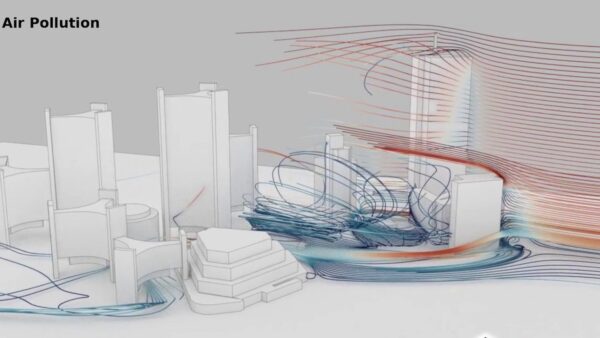Architects and designers may soon be able to optimise air quality in and around buildings using real-time data via a BIM software plugin.
The Digital Building Design (D-BuD) for Optimum Pollution Dispersion project is funded by Innovate UK. It is an AI-driven feasibility study focused on enhancing air quality and pollution dispersion in urban environments. The project provides architects, builders and urban planners with data-driven insights to design sustainable building layouts that comply with regulations and promote public health.
The D-BuD initiative uses data from indoor and outdoor air quality sensors, weather patterns, traffic flow, wind direction and GIS to inform the design process. The ultimate objective is to develop an AI-powered D-BuD plugin for BIM software, enabling real-time optimisation of air dispersal and indoor air quality during the design phase.
The project is led by Dr Mohammad Nazir OBE, managing director of Nazir Associates, and Professor HaIiz Alaka, associate dean and director of the Ai & Big Data Technologies and Innovations Laboratory at the University of Hertfordshire.
Dr Nazir said: “In the construction industry, sustainable and intelligent design is no longer optional but essential. Our D-BuD project provides the tools necessary for architects and urban planners to design buildings that not only meet regulatory standards, but also promote the health and wellbeing of their occupants and the surrounding community.”
Professor Alaka added: “By integrating AI with comprehensive environmental data, we can offer precise and actionable insights that drive smarter construction practices. This project is a significant step towards building healthier and more sustainable cities.”
The project will be launched at a webinar in March.
Don’t miss out on BIM, information management and digital construction news: sign up to receive the BIMplus newsletter.
The post Incorporating urban air quality into BIM with data and AI appeared first on BIM+.
Architects and designers may soon be able to optimise air quality in and around buildings using real-time data via a BIM software plugin.
The Digital Building Design (D-BuD) for Optimum Pollution Dispersion project is funded by Innovate UK. It is an AI-driven feasibility study focused on enhancing air quality and pollution dispersion in urban environments. The project provides architects, builders and urban planners with data-driven insights to design sustainable building layouts that comply with regulations and promote public health.
The D-BuD initiative uses data from indoor and outdoor air quality sensors, weather patterns, traffic flow, wind direction and GIS to inform the design process. The ultimate objective is to develop an AI-powered D-BuD plugin for BIM software, enabling real-time optimisation of air dispersal and indoor air quality during the design phase.
The project is led by Dr Mohammad Nazir OBE, managing director of Nazir Associates, and Professor HaIiz Alaka, associate dean and director of the Ai & Big Data Technologies and Innovations Laboratory at the University of Hertfordshire.
Dr Nazir said: “In the construction industry, sustainable and intelligent design is no longer optional but essential. Our D-BuD project provides the tools necessary for architects and urban planners to design buildings that not only meet regulatory standards, but also promote the health and wellbeing of their occupants and the surrounding community.”
Professor Alaka added: “By integrating AI with comprehensive environmental data, we can offer precise and actionable insights that drive smarter construction practices. This project is a significant step towards building healthier and more sustainable cities.”
The project will be launched at a webinar in March.
Don’t miss out on BIM, information management and digital construction news: sign up to receive the BIMplus newsletter.
The post Incorporating urban air quality into BIM with data and AI appeared first on BIM+.
Architects and designers may soon be able to optimise air quality in and around buildings using real-time data and AI via a BIM software plugin.
The post Incorporating urban air quality into BIM with data and AI appeared first on BIM+.


